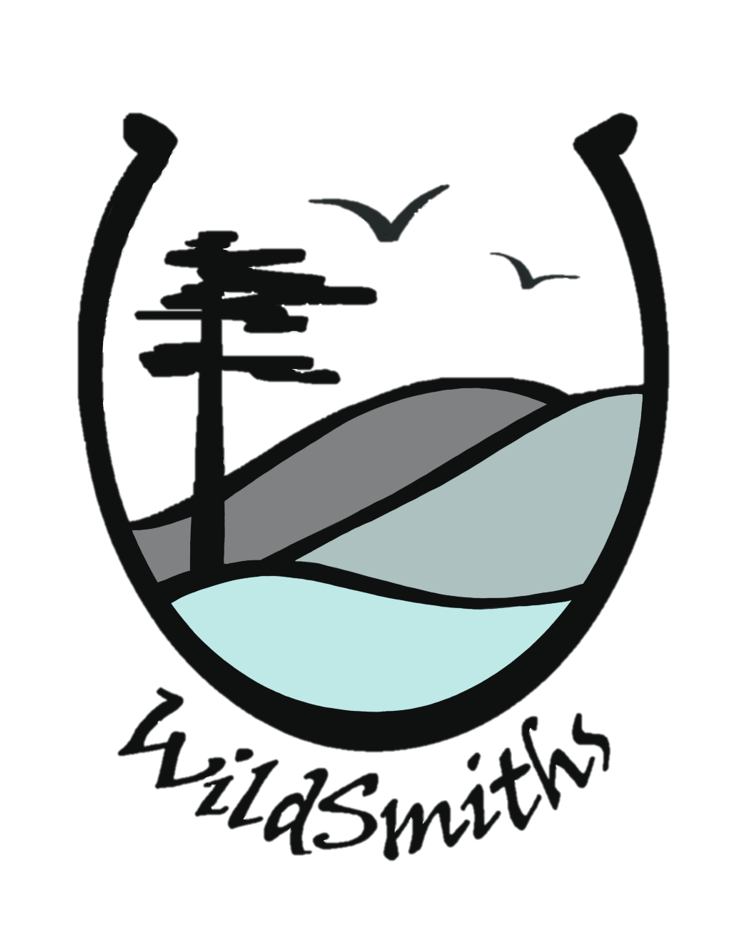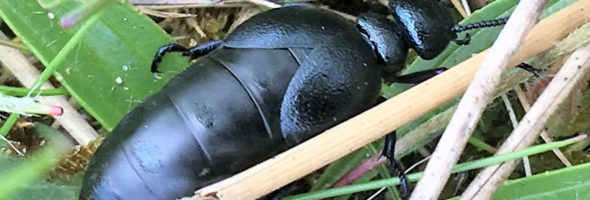
Two interesting insects, that WildSmiths always love to see on the Isle of Coll, are the Short-necked Oil Beetle and the Belted Beauty moth. They are both very rare nationally but are regularly seen on this tiny island. As ‘flightless fliers’, the pair of them also illustrate the extraordinary and wonderful complexity of nature. You can read about the moth here. In this blog, we’re going to take a look at the beetle.
Oil beetles are so called because they produce a caustic, orange, oily substance (cantharadin) from their leg joints when disturbed or threatened. This irritant was used in the Middle Ages as a medicinal compound – especially for the treatment of warts – and also as an aphrodisiac. Indeed, no self-respecting apothecary’s collection was complete without a jar of dried oil beetles. Today, in this country at least, man’s relationship with them is rather more benign; after years spent driving them towards extinction, we now focus on their conservation, rather than their consumption.

So how are they doing? The five species of oil beetle in the UK are all pretty rare but none more so than the short-necked variety (Meloe brevicollis). Until very recently, this species was thought to be extinct in the UK, with the last sighting in Sussex in the 1940s. Then, in early 2006, an entomologist found 40 individuals on clifftop grassland at a National Trust farm on the Devon coast, over a hundred years after it had last been seen there. Imagine how exciting that must have been!
Even more amazingly, two years after that, the species was then found on the Isle of Coll by colleagues at the RSPB – although it had never been recorded anywhere in Scotland before. Surveys since (some of which WildSmiths have been pleased to help with) have found it well-established in several different sand dune locations on the island.
What do they look like? Sarah and I are by no means expert coleopterists (the technical term for beetle botherers) but, thankfully, oil beetles are not difficult to locate and identify – they are active by day and are fat, lumbering beasts with distinctive curved abdomens and short wing-cases. A BBC naturalist recently used a distinctive phrase to describe their appearance: “portly gentlemen who’ve outgrown their dinner-jackets”.
Another image we like derives from the Spanish name for them, frailecillo which means ‘little friar’ (a reference to their monk-like appearance); this in turn echoes the scientific name of another plump Hebridean speciality, the Puffin (Fratercula arctica). However, unlike the Puffin, the oil beetle is flightless – at least in the strict meaning of the word…

Besides its astonishing rarity in Britain, the thing that makes the oil beetle really unusual is its lifecycle. The standard beetle lifecycle goes: egg → larva → pupa → adult. The larval (or ‘stuffing itself’) stage usually has several steps (or instars) in which it sheds its skin as it grows steadily fatter. Remarkably, the oil beetle inserts an additional step into this sequence between egg and larva: the ‘triungulin’ stage, or what might more informatively be called the ‘running, jumping and clinging on for dear life’ stage. The word triungulin is a reference to its three-clawed feet. Steven Falk has an excellent set of photos of the various oil beetles and some of their triungulins on his Flicker account here.
What does the triungulin do? Well, to understand why the oil beetle has evolved this extra stage in its hyper-metamorphic lifecycle, you need to know that it spends the ‘stuffing itself’ stage of its life in the nests of solitary bees. The triungulin is the means it uses to find these nests. In short, after emerging from the egg, the tiny triungulin climbs to the top of the nearest flower (usually a yellow hawkbit or dandelion) and lies in wait for a bee of the right species to visit the flower. At this point, it leaps aboard the bee (sometimes several triungulins at a time) and hitches a ride back to the nest, clinging on for dear life with those three-clawed feet. The bee has been laying eggs in the nest and storing food supplies for its developing young and it is here that the beetle, once it has gone through its next metamorphosis into the larval stage, starts to stuff itself, munching through the contents of the nest. What a finely developed and sophisticated parasitic behaviour!

So how does this remarkable flightless beetle come to be on the Isle of Coll? Has it always been there but just gone unnoticed? This seems unlikely, as Coll has always been a popular destination for naturalists and (in our experience at least) the oil beetle is not easily over-looked. So an alternative theory might be that a triungulin-bearing bee has flown there from elsewhere, Ireland perhaps (where this species of oil beetle is known from just one locality)? But a single triungulin would be unable to produce another generation of beetles, so either the bee was carrying more than one, or this unlikely occurrence happened twice. That too begins to sound far-fetched. Well, however it got there, let’s delight in its presence. The adults are around from March to May and the triungulins emerge in June. If you join WildSmiths for a walk on Coll, we’ll see if we can find a Short-necked Oil Beetle together.


